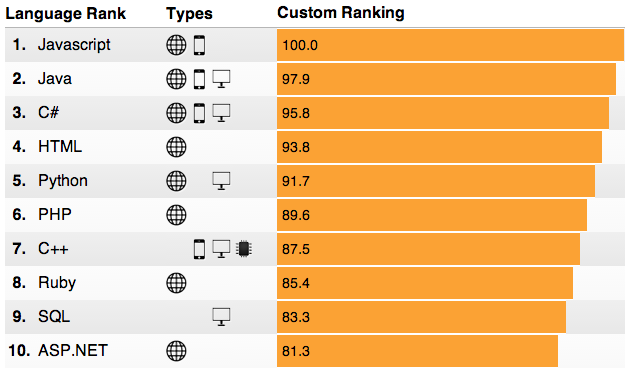We knew StackOverflow was different. Turns out it’s, well, really different.
The technical Q&A site looks like your standard Web developer hangout. But according to new data from IEEE Spectrum, its community has some unusual technical tastes. For instance, its readers evince a serious interest in the niche-y area of embedded hardware development—that is, programmable systems that typically live inside other gadgets and don’t expose a user interface to the average person.
On the other hand, this data doesn’t necessarily mean researchers have uncovered unexpected pockets of embedded or enterprise popularity, Maybe StackOverflow’s community preferences is simply telling us how poorly documented these technologies are—and how the right online forum can self-organize to meet the needs of developers who have to work with them.
Correlating Online Technical Communities
In response to IEEE Spectrum’s new programming language popularity analysis tool, Redmonk analyst Donnie Berkholz set out to try to uncover “commonalities and communities across all of [different] sources” so as to glean “insight into what technologies developers care about and use, and which provide mainly reinforcement of others.”
So, when comparing the popularity of programming languages as measured by jobs vs. which ones get discussed on social media and open-source code hubs, the top-10 programming languages look like this:

Some correlations he found make intuitive sense.
For example, there is an exceptionally strong correlation between Twitter conversation and Google trends. As he puts it, “people talking about programming languages in real-time chat tend to also search for what they’re talking about.”
Berkholz also uncovered very strong correlations (above 0.85) between Google Trends and search; programming language interest across different job sites like Dice and CareerBuilder; Reddit and Google Trends (developers look for information about current topics on different sites); and GitHub created and StackOverflow questions (a correlation of open-source usage and broader conversation among forward-leaning communities).
Others correlate more weakly between sources—like HackerNews with most everything else.
But StackOverflow stands out.
StackOverflow Developers: A Breed Apart?
In fact, StackOverflow developers stand alone. Completely alone, it would seem from Berkholz’s analysis. As he notes:
The weakest correlations were between StackOverflow views and almost everything else. It’s shocking how different the visitors to StackOverflow seem from every other data source.
Here are the top-10 programming languages on StackOverflow in terms of what readers actually read:

These results differ markedly from all other sources. As Berkholz highlights:
Three of the top 5 are hardware (Arduino, VHDL, Verilog), supporting a strong audience of embedded developers. Outside of StackOverflow views, these languages are nonexistent in the top 10 with only two exceptions: Arduino is #7 on Reddit and VHDL is #8 in IEEE Xplor. That paints a very clear contrast between this group and everyone else, and perhaps a unique source of data about trends in embedded development. Enterprise stalwarts are also commonplace, such as Visual Basic, Cobol, Apex (Salesforce.com’s language), and ABAP (SAP’s language).
This could suggest that StackOverflow is a leading indicator of hot new technologies. For example, the hardware bent to its audience might point to rising interest in the Internet of Things, which is going to be built on top of a whole lot of, well, embedded hardware systems.
Or, frankly, it could just mean that StackOverflow does a particularly good job of providing a home to smaller communities of embedded and enterprise developers that can’t get good documentation from Salesforce.com.
I mean, really, who wants to hang out in IBM’s Cobol Café?
But Who Are These People?
While we don’t have data from 2013 or 2014, in December 2011 someone took a survey of 2,532 StackOverflow users. A significant chunk of StackOverflow users come from the U.S., with the largest percentage (12%) in California and the second largest (8.4%) in New York, with a majority (53%) aged 25-34 and 68% having at least 6 years of IT/programming experience.
Not particularly surprising.
What is surprising, given the IEEE Spectrum data, is that a whopping 40% describe themselves as web application developers while only 4.3% are embedded application developers. Most are building enterprise applications (32%) or web platforms (33%), but the languages they indicate they know differ from the languages they view on StackOverflow:

This jibes with the enterprise developer finding in the IEEE Spectrum data. It’s still hard to see the embedded hardware developer in these numbers—though not so hard to uncover the enterprise developer.
This becomes more pronounced if we only look at StackOverflow users who answer questions (and not necessarily those that read the answers):

In short, there’s a difference between those that answer questions and those that merely lurk. For example, the top 20 most active StackOverflow participants have little to do with embedded engineering, as this data visualization shows. (Click through to see what each works on.)
StackOverflow Is Unique
So while StackOverflow has its share of mainstream Java and JavaScript folks answering questions, what many people really find useful are its sub-communities for embedded programming and enterprise development that aren’t really replicated anywhere else, as Berkholz posits.
Such technologies don’t have great documentation within their home communities (e.g., Salesforce.com’s Apex language), but StackOverflow has become the go-to home-away-from-home community for these embedded and enterprise technologies.
There are far more questions tagged “Java” (625,000+), for example, than for Arduino (12,000+), but according to the IEEE Spectrum data there’s way more reader interest in the latter than the former. The IEEE Spectrum approach measures both the number of questions posted mentioning each language in 2013 and the amount of attention paid to those questions. In StackOverflow’s world, people pay far more interest to embedded and enterprise than general Web development, even though its user base has historically skewed web developer.
A different breed, indeed. Or, quite possibly, an indication of mainstream enterprise and web developers looking beyond “mainstream” to tap into the Internet of Things applications or other modern applications?
Lead image by Flickr user Alexandre Dulaunoy, CC 2.0

















